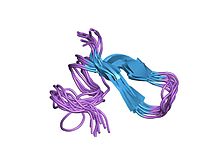
Nicotiana is a genus of herbaceous plants and shrubs in the family Solanaceae, that is indigenous to the Americas, Australia, Southwestern Africa and the South Pacific. Various Nicotiana species, commonly referred to as tobacco plants, are cultivated as ornamental garden plants. N. tabacum is grown worldwide for the cultivation of tobacco leaves used for manufacturing and producing tobacco products, including cigars, cigarillos, cigarettes, chewing tobacco, dipping tobacco, snuff, and snus.

The Noctuidae, commonly known as owlet moths, cutworms or armyworms, are a family of moths. They are considered the most controversial family in the superfamily Noctuoidea because many of the clades are constantly changing, along with the other families of the Noctuoidea. It was considered the largest family in Lepidoptera for a long time, but after regrouping Lymantriinae, Catocalinae and Calpinae within the family Erebidae, the latter holds this title now. Currently, Noctuidae is the second largest family in Noctuoidea, with about 1,089 genera and 11,772 species. This classification is still contingent, as more changes continue to appear between Noctuidae and Erebidae.
Juvenile hormones (JHs) are a group of acyclic sesquiterpenoids that regulate many aspects of insect physiology. The first discovery of a JH was by Vincent Wigglesworth. JHs regulate development, reproduction, diapause, and polyphenisms. The chemical formula for juvenile hormone is .
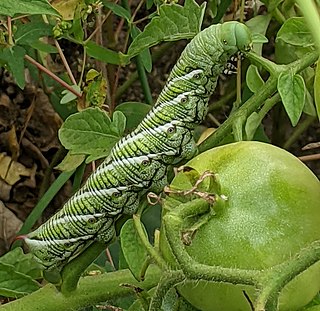
Manduca sexta is a moth of the family Sphingidae present through much of the Americas. The species was first described by Carl Linnaeus in his 1763 Centuria Insectorum.

The beet armyworm or small mottled willow moth is one of the best-known agricultural pest insects. It is also known as the asparagus fern caterpillar. It is native to Asia, but has been introduced worldwide and is now found almost anywhere its many host crops are grown. The voracious larvae are the main culprits. In the British Isles, where it is an introduced species and not known to breed, the adult moth is known as the small mottled willow moth.

L-(+)-(S)-Canavanine is a non-proteinogenic amino acid found in certain leguminous plants. It is structurally related to the proteinogenic α-amino acid L-arginine, the sole difference being the replacement of a methylene bridge (-CH
2- unit) in arginine with an oxa group (i.e., an oxygen atom) in canavanine. Canavanine is accumulated primarily in the seeds of the organisms which produce it, where it serves both as a highly deleterious defensive compound against herbivores (due to cells mistaking it for arginine) and a vital source of nitrogen for the growing embryo. The related L-canaline is similar to ornithine.

The African armyworm, also called okalombo, kommandowurm, or nutgrass armyworm, is a species of moth of the family Noctuidae. The larvae often exhibit marching behavior when traveling to feeding sites, leading to the common name "armyworm". The caterpillars exhibit density-dependent polyphenism where larvae raised in isolation are green, while those raised in groups are black. These phases are termed solitaria and gregaria, respectively. Gregaria caterpillars are considered very deleterious pests, capable of destroying entire crops in a matter of weeks. The larvae feed on all types of grasses, early stages of cereal crops, sugarcane, and occasionally on coconut. The solitaria caterpillars are less active and undergo much slower development. The species is commonly found in Africa, but can also be seen in Yemen, some Pacific islands, and parts of Australia. African armyworm outbreaks tend to be devastating for farmland and pasture in these areas, with the highest-density outbreaks occurring during the rainy season after periods of prolonged drought. During the long dry seasons ("off-season"), the population densities are very low and no outbreaks are seen.

Ascoviridae is a family of double strand DNA viruses that infect primarily invertebrates, mainly noctuids and spodoptera species; it contains two genera, Ascovirus, which contains three species, and Toursvirus with a single species Diadromus pulchellus toursvirus.
Crustacean cardioactive peptide (CCAP) is a highly conserved, amidated cyclic nonapeptide with the primary structure PFCNAFTGC-NH2 (ProPheCysAsnAlaPheTyrGlyCys-NH2) and a disulfide bridge between Cys3 and Cys9. It is found in crustaceans and insects where it behaves as a cardioaccelerator, neuropeptide transmitter for other areas of the nervous system and a hormone. CCAP was first isolated from the pericardial organs of the shore crab Carcinus maenas, where it has a role in regulating heartbeat. It was assumed that this was the peptide's main function and its name reflects this.
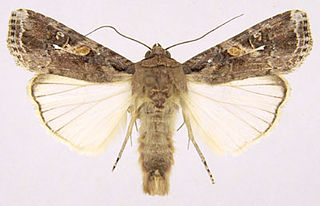
The fall armyworm is a species in the order Lepidoptera and one of the species of the fall armyworm moths distinguished by their larval life stage. The term "armyworm" can refer to several species, often describing the large-scale invasive behavior of the species' larval stage. It is regarded as a pest and can damage and destroy a wide variety of crops, which causes large economic damage. Its scientific name derives from frugiperda, which is Latin for lost fruit, named because of the species' ability to destroy crops. Because of its propensity for destruction, the fall armyworm's habits and possibilities for crop protection have been studied in depth. It is also a notable case for studying sympatric speciation, as it appears to be diverging into two species currently. Another remarkable trait of the larva is that they consistently practice cannibalism, despite its fitness costs.

Spodoptera is a genus of moths of the family Noctuidae erected by Achille Guenée in 1852. Many are known as pest insects. The larvae are sometimes called armyworms. The roughly thirty species are distributed across six continents.

Iflaviridae is a family of positive sense RNA viruses insect-infecting viruses. Some of the insects commonly infected by iflaviruses include aphids, leafhoppers, flies, bees, ants, silkworms and wasps. The name "Ifla" is derived from the name "Infectious flacherie virus", a member species. There is one genus (Iflavirus) and 16 species in this family.
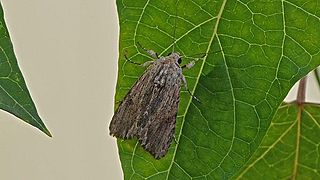
Spodoptera eridania is a moth that is known to be a pest. They are one of the most important defoliators in the tropical and subtropical regions of the western hemisphere that feed heavily on plants while they are young, often resulting in skeleton leaves on their food plants. They are also heavy feeders on tomato in Florida. There is a lot of development in producing pesticides against the S. eridania, specifically a neem-based pesticide that can result in smaller and prolonged development. The wingspan is 33–38 mm. Adults are on wing year-round. The larvae feed on various weeds but prefer Amaranthus species and Phytolacca americana.
Pyruvate cycling commonly refers to an intracellular loop of spatial movements and chemical transformations involving pyruvate. Spatial movements occur between mitochondria and cytosol and chemical transformations create various Krebs cycle intermediates. In all variants, pyruvate is imported into the mitochondrion for processing through part of the Krebs cycle. In addition to pyruvate, alpha-ketoglutarate may also be imported. At various points, the intermediate product is exported to the cytosol for additional transformations and then re-imported. Three specific pyruvate cycles are generally considered, each named for the principal molecule exported from the mitochondrion: malate, citrate, and isocitrate. Other variants may exist, such as dissipative or "futile" pyruvate cycles.
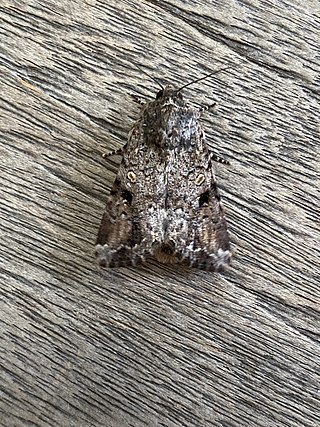
Spodoptera mauritia, the lawn armyworm or paddy swarming caterpillar, is a moth of the family Noctuidae. The species was first described by Jean Baptiste Boisduval in 1833. Able to eat many types of food, it is a major pest throughout the world.
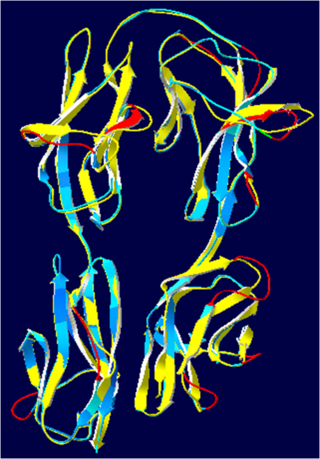
Hemolin is an immunoglobulin-like protein exclusively found in Lepidoptera. It was first discovered in immune-challenged pupae of Hyalophora cecropia and Manduca sexta.

The protein Sf caspase-1 is the insect ortholog of the human effector caspases CASP3 (CPP32) and CASP7 (MCH3) in the species Spodoptera frugiperda. It was identified as the target of the baculoviral caspase inhibitor protein P35, which it cleaves and by which it is inhibited. Like other caspases, Sf caspase-1 is an aspartate-specific cysteine protease that is produced as an inactive proenzyme and becomes activated by autocatalytic cleavage. The Sf caspase-1 proenzyme is cleaved after the amino acid residues Asp-28 and Asp-195, resulting in a smaller 12 kDa fragment and a larger 19 kDa fragment. Just like with human caspases CASP3 or CASP7, the two cleavage fragments form heterodimers, which again form biologically active dimers-of-heterodimers consisting of two smaller and two larger fragments. Some experiments also showed cleavage of Sf caspase-1 at the residue Asp-184, resulting in an 18 kDa instead of 19 kDa fragment, however this result is likely an in vitro artefact. The insect immunophilin FKBP46 is a substrate of Sf caspase-1, which cleaves full length FKBP46 resulting in a ~25 kDa fragment.
Helicoverpa zea nudivirus 2 is an enveloped, rod-shaped, nonoccluded, double stranded DNA (dsDNA) sexually transmitted virus whose natural host is the corn earworm moth. At about 440 by 90 nm, it is the causative agent of the only sexually transmitted viral disease of any insect. It was originally identified in a colony of corn earworm moths established and maintained in Stoneville, Mississippi, U.S. and was found to be responsible for the sterility of those infected.
Cytochrome P450, family 9, also known as CYP9, is a cytochrome P450 family found in Insect genome, CYP9 and insect CYP6 family belong to the same clan as mammalian CYP3 and CYP5 families. The first gene identified in this family is the CYP9A1 from the Heliothis virescens, which is involved in thiodicarb insecticide resistance. Subfamily CYP9A in Lepidopteran play important roles in insecticide resistance, can metabolize esfenvalerate efficiently.
Cotesia icipe is a parasitoid species of wasp of the genus Cotesia. Found in tropical Africa and the Arabian Peninsula, it was first discovered as a parasitoid of the Lepidopterans Spodoptera littoralis and beet armyworm. Therefore it is now being studied as a possible biological control of Lepidopteran pests of amaranth crops in those areas.
